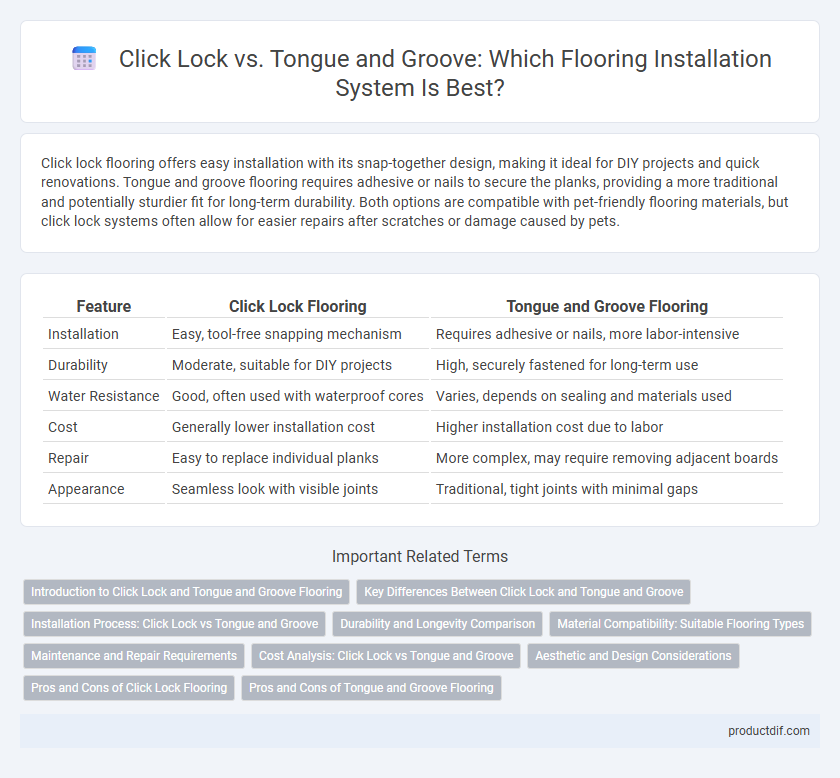Click lock flooring offers easy installation with its snap-together design, making it ideal for DIY projects and quick renovations. Tongue and groove flooring requires adhesive or nails to secure the planks, providing a more traditional and potentially sturdier fit for long-term durability. Both options are compatible with pet-friendly flooring materials, but click lock systems often allow for easier repairs after scratches or damage caused by pets.
Table of Comparison
| Feature | Click Lock Flooring | Tongue and Groove Flooring |
|---|---|---|
| Installation | Easy, tool-free snapping mechanism | Requires adhesive or nails, more labor-intensive |
| Durability | Moderate, suitable for DIY projects | High, securely fastened for long-term use |
| Water Resistance | Good, often used with waterproof cores | Varies, depends on sealing and materials used |
| Cost | Generally lower installation cost | Higher installation cost due to labor |
| Repair | Easy to replace individual planks | More complex, may require removing adjacent boards |
| Appearance | Seamless look with visible joints | Traditional, tight joints with minimal gaps |
Introduction to Click Lock and Tongue and Groove Flooring
Click lock flooring features interlocking edges that snap together without the need for glue or nails, offering ease of installation and durability. Tongue and groove flooring involves a protruding tongue on one board fitting into a corresponding groove on another, creating a tight, secure joint commonly used in hardwood floors. Both systems provide stability and smooth surface continuity, but click lock flooring is often favored for DIY projects due to its simpler installation process.
Key Differences Between Click Lock and Tongue and Groove
Click lock flooring systems feature interlocking planks that snap together without the need for nails or glue, offering quick and easy installation. Tongue and groove flooring requires each plank's tongue to fit into the adjacent plank's groove, often needing adhesives or nails for secure fastening. While click lock provides a floating floor option with simpler replacement, tongue and groove offers a tighter, more permanent fit commonly used in traditional hardwood installations.
Installation Process: Click Lock vs Tongue and Groove
Click lock flooring features a simple installation process where planks snap together without the need for glue or nails, making it suitable for DIY projects and faster completion times. Tongue and groove flooring requires precise alignment of the tongue into the groove, often necessitating adhesive or nails, which can increase installation complexity and time. The click lock system generally offers a more user-friendly and efficient installation compared to the traditional tongue and groove method.
Durability and Longevity Comparison
Click lock flooring offers enhanced durability due to its interlocking mechanism, which prevents gaps and reduces movement, making it ideal for high-traffic areas. Tongue and groove flooring provides a traditional, tight fit with strong adhesive bonding, contributing to long-term stability but may be more susceptible to moisture damage over time. Overall, click lock systems generally outperform tongue and groove in longevity, especially in environments prone to humidity and frequent use.
Material Compatibility: Suitable Flooring Types
Click lock flooring systems are highly compatible with laminate, vinyl, and engineered hardwood, offering easy installation without adhesives. Tongue and groove joints are preferred for solid hardwood and traditional wood flooring due to their secure fit and moisture resistance. Both methods accommodate various underlayment types, but click lock excels in floating floor installations, enhancing versatility across different materials.
Maintenance and Repair Requirements
Click lock flooring offers easier maintenance and repair due to its floating installation, allowing individual planks to be replaced without disturbing surrounding sections. Tongue and groove flooring requires more intensive maintenance as boards are glued or nailed down, making repairs more labor-intensive and potentially damaging to adjacent planks. Both types benefit from regular cleaning and moisture control, but click lock systems provide superior convenience for DIY repairs and upkeep.
Cost Analysis: Click Lock vs Tongue and Groove
Click lock flooring typically costs more upfront due to its advanced locking mechanism, which simplifies installation and reduces the need for professional labor. Tongue and groove flooring, while generally less expensive per square foot, often incurs higher installation costs because it requires more precise fitting and sometimes adhesives or nails. Overall, click lock systems offer better value by minimizing labor expenses, whereas tongue and groove may appeal to budget-conscious buyers willing to invest time or hire skilled installers.
Aesthetic and Design Considerations
Click lock flooring offers a seamless, modern aesthetic with uniform spacing and minimal visible joints, enhancing sleek, contemporary interiors. Tongue and groove flooring provides a traditional, classic appeal with tighter fit and subtle shadow lines that highlight plank detail and craftsmanship. Both systems allow for diverse design versatility, but click lock is favored for quick installation and clean lines, while tongue and groove accentuates natural wood textures and intricate patterns.
Pros and Cons of Click Lock Flooring
Click lock flooring offers easy installation with a floating system that requires no glue or nails, making it ideal for DIY projects and quick repairs. It provides good durability and can be installed over various subfloors, but may be prone to slight movement or gaps over time compared to tongue and groove. Maintenance is straightforward, though the interlocking mechanism can sometimes loosen in high-traffic areas, affecting long-term stability.
Pros and Cons of Tongue and Groove Flooring
Tongue and groove flooring offers a robust and tight fit between planks, providing excellent stability and a seamless appearance ideal for hardwood and laminate floors. It requires professional installation due to the need for precise alignment and can be time-consuming, especially when dealing with uneven subfloors. Moisture resistance is lower compared to click lock systems, making tongue and groove less suitable for high-humidity environments.
Click Lock vs Tongue and Groove Infographic

 productdif.com
productdif.com